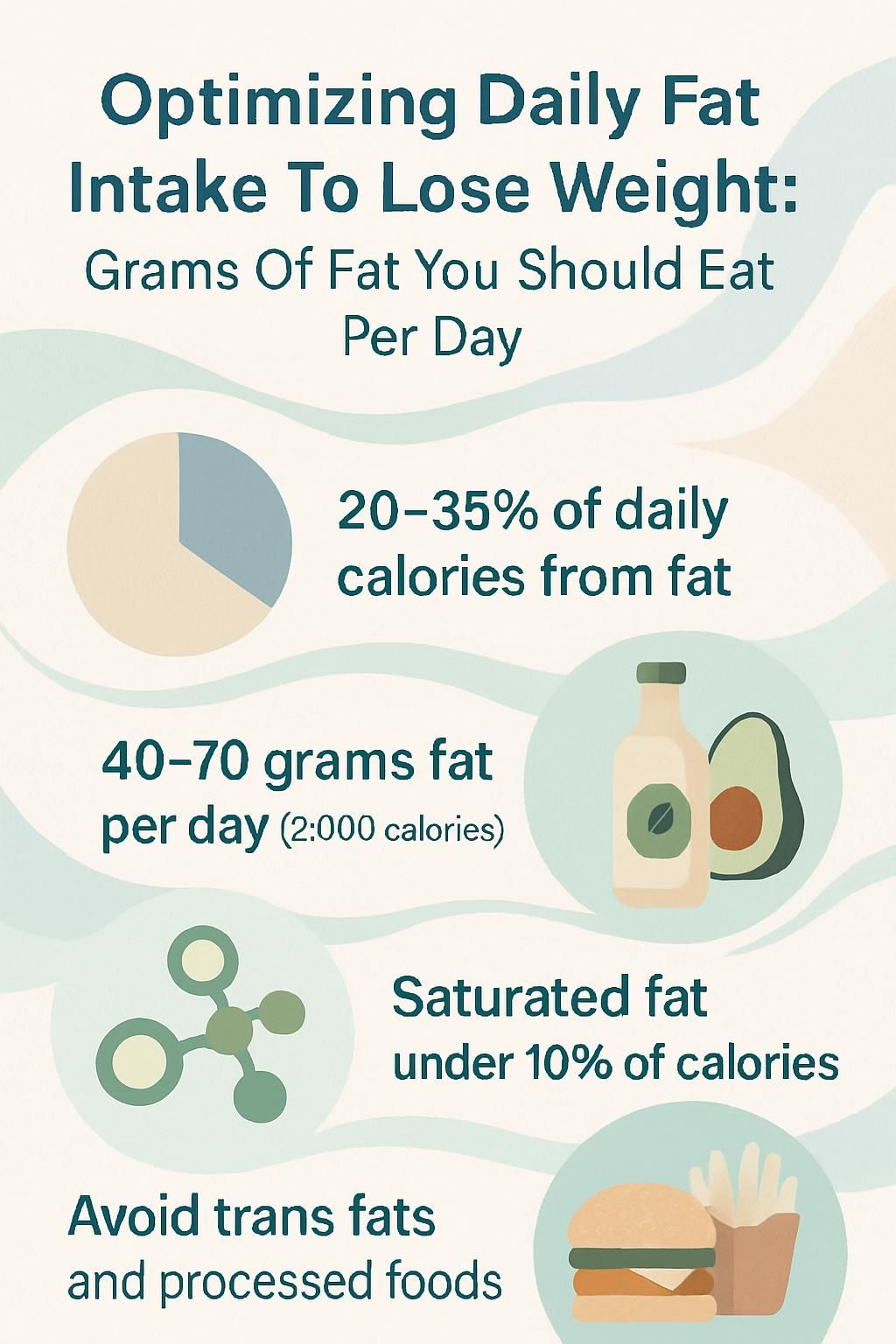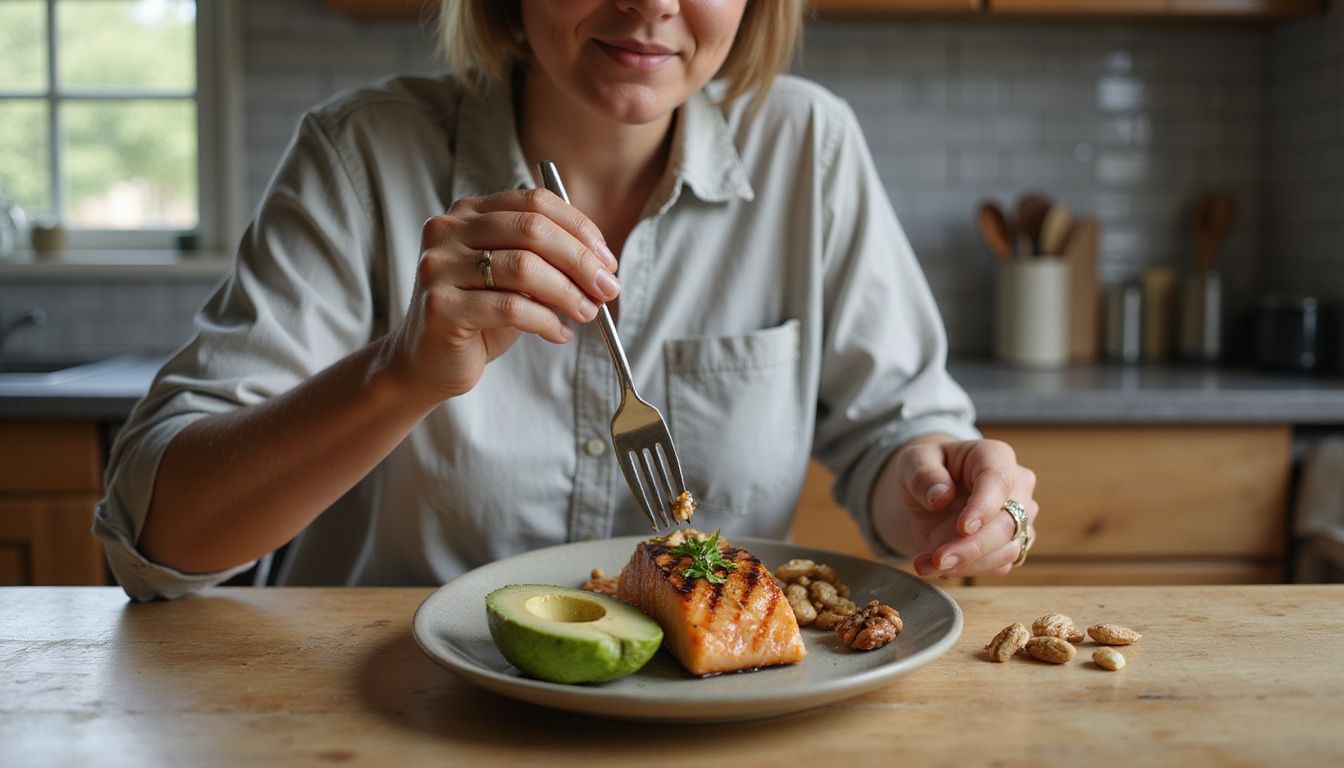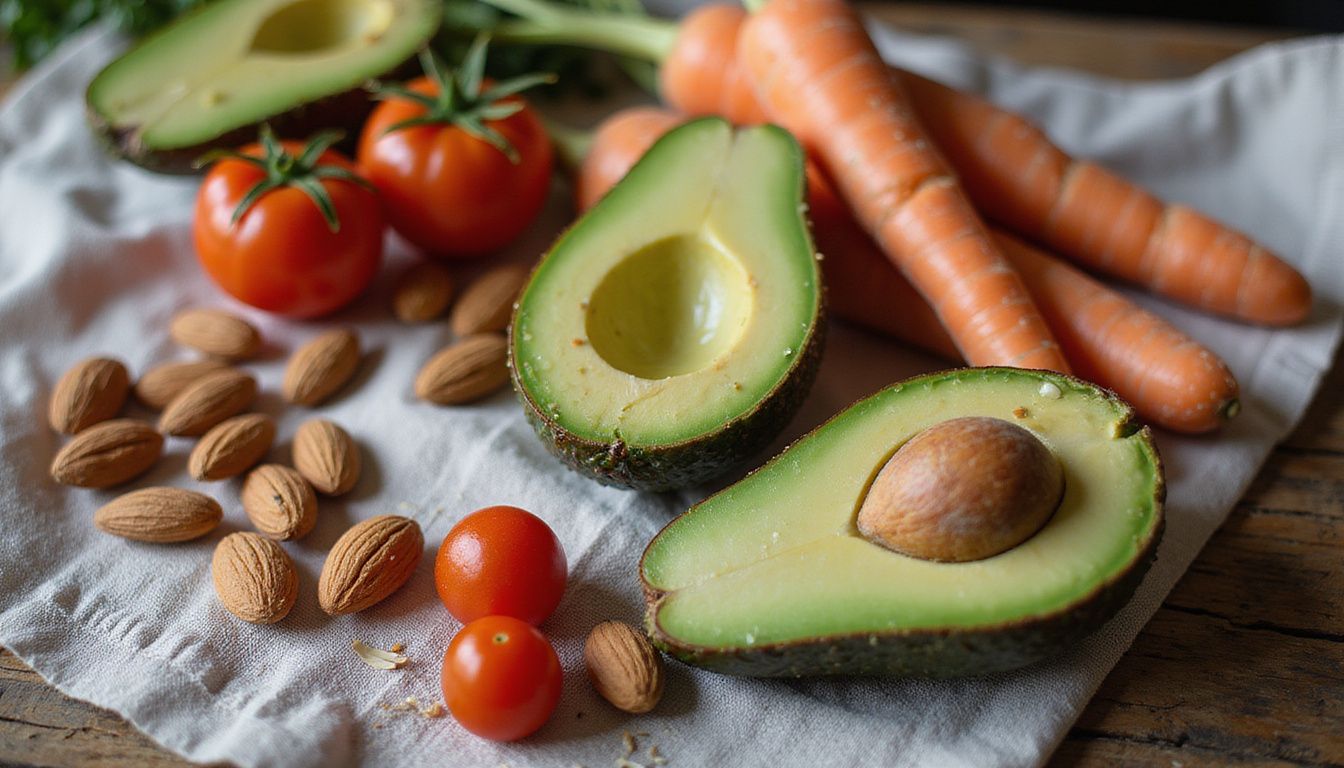Optimizing Daily Fat Intake To Lose Weight: Grams Of Fat You Should Eat Per Day
Our Nutrition Assistant AI Suite will transform your body. You will lose fat, get toned, and build muscle. Gain confidence and optimal health.
If you feel unsure about how much fat to eat to lose weight, you are not alone. Fat is part of a healthy diet and supports your body, even during weight loss. Understanding daily fat intake helps you avoid eating too little or choosing the wrong types.
This guide explains how many grams of fat to eat per day, which fats to choose or limit, and how fat fits into a smart weight loss plan. Simple changes can make progress easier.
Key Takeaways
- Aim for 20–35% of daily calories from fat. On a 2,000-calorie plan, that is about 44–78 grams per day to support weight loss.
- Keep saturated fat under 10% of calories. That equals about 13 grams on a 2,000-calorie plan. Avoid trans fat to protect heart health.
- Prioritize healthy fats such as olive oil, avocados, nuts, seeds, and fatty fish. These choices can lower LDL cholesterol and reduce inflammation while supporting steady energy.
- Use food labels to track total fat and saturated fat. Limit foods with hidden trans fat, like fried snacks and some baked items.
- Work with a registered dietitian to personalize fat goals based on age, activity, health, and specific weight targets.

Why Is Fat Important for Your Diet?

Fat is not just a calorie source. It supports hormones, cell health, and steady energy. Eating enough fat each day can help you manage weight and avoid nutrient gaps.
What role does fat play in the body?
Your body uses fat to build and protect cells, cushion organs, and control temperature. It is also an important energy source, especially if your carb intake is lower. Fat helps you absorb vitamins A, D, E, and K, which are fat soluble.
Severely low fat intake may cause dry skin, slow wound healing, or hormone issues. Extra energy is stored as body fat in adipose tissue, which your body can use later. I once cut fat too hard and ended up tired with dry skin. A balanced amount of healthy fat brought my energy back.
What are the benefits of healthy fats?
Healthy fats, especially unsaturated fats, support heart health and weight control. Monounsaturated fats from olive oil and avocados can lower LDL cholesterol while supporting HDL. Omega-3 fats from fish help reduce heart disease risk and lower triglycerides.
These fats add flavor and help you feel full, which can reduce daily calories. They also support skin, brain function, and healthy inflammation levels. Knowing the types of dietary fat makes daily choices much easier.
Types of Dietary Fat
Dietary fat includes several types, and each affects health differently. Learning the types of fat you eat can guide better choices for weight loss and health.
What are saturated fats?
Saturated fats are solid at room temperature. They are common in butter, fatty cuts of meat, full-fat dairy, and poultry skin. Some plant oils, such as coconut and palm oil, also contain a lot of saturated fat. Many fast food items and fried foods are high in these fats.
The American Heart Association suggests limiting saturated fat to 5–6% of daily calories. On a 2,000-calorie diet, that is about 13 grams per day. UK guidance advises no more than 30 grams per day for men and 20 grams for women. Higher intake can raise LDL cholesterol and increase the risk of cardiovascular disease and type 2 diabetes.
Saturated fat is mainly found in animal foods and some plant-based oils.
Why are trans fats harmful?
Trans fats are industrial fats created through hydrogenation, which turns oil into a solid to extend shelf life. They appear in some frozen baked goods, fried foods, stick margarine, and non-dairy creamers. Even small amounts raise LDL, lower HDL, and increase the risk of coronary artery disease.
The Dietary Guidelines for Americans advise avoiding trans fat. Labels can be tricky, since products with under 0.5 grams per serving may say “0g trans fat.” Check for “hydrogenated” or “partially hydrogenated” oils in the ingredient list. I found hidden trans fat in snacks that looked “healthy.” Cutting them helped me stay on track.
What are monounsaturated fats?
Monounsaturated fats are heart-friendly fats found in avocados, peanuts, olives, nuts, and olive oil. They are liquid at room temperature and supply vitamin E and antioxidants. Replacing saturated fat with these fats can lower LDL cholesterol.
The Mediterranean diet, which is rich in olive oil and nuts, shows strong benefits for blood lipids and long-term health. Choosing these fats supports healthy cell membranes and may help with weight control when they replace higher saturated fat foods.
What are polyunsaturated fats?
Polyunsaturated fats, found in safflower, sunflower, sesame, soybean, and corn oils, are also liquid at room temperature. They include omega-3 and omega-6 fatty acids, which your body cannot make on its own. You get them from nuts, seeds, plant oils, and fatty fish.
Replacing saturated fats with polyunsaturated fats can lower LDL. These fats also help manage inflammation and support brain and eye health. Switching from butter to sunflower or canola oil helped my cholesterol improve at my last checkup.
How Many Grams of Fat Should You Eat Per Day?
Your target for grams of fat depends on your daily calories, goals, and health. A clear target keeps your plan simple and measurable.
What are the general guidelines for fat intake?
The Dietary Guidelines for Americans recommend 20–35% of total daily calories from fat. On a 2,000-calorie plan, that equals about 44–78 grams per day. Children ages 2–3 need 30–40% of calories from fat. Ages 4–18 should aim for 25–35%.
Keep saturated and trans fats under 10% of total calories. Needs vary with age, sex, and activity. A calorie calculator, such as Mifflin St Jeor, can estimate your daily calories. I used a simple app to track fat and felt more energetic while avoiding weight gain.
How much fat should you eat to lose weight?
For weight loss, aim for 20–35% of calories from dietary fat. If results stall, move closer to 20% while keeping protein and fiber adequate. A 150-pound person, about 68 kilograms, might target 34–68 grams of fat per day.
Very low fat diets under 20% can be hard to maintain long term. Many people do well with a moderate-fat approach that replaces saturated fat with unsaturated options. Swapping fried snacks for a small portion of nuts or avocado helped me feel full without overshooting daily calories.
Calculating Your Daily Fat Intake
A little math helps you turn calorie goals into fat grams. This makes tracking easier and more precise.
How do you convert calories to grams of fat?
First, choose your target percent of calories from fat. Next, multiply your total daily calories by that percent. Fat has 9 calories per gram, so divide the fat calories by 9 to get grams of fat.
- Example: 1,800 calories x 30% equals 540 calories from fat.
- 540 calories divided by 9 equals about 60 grams of fat per day.
Online calculators can do this for you and adjust for age, weight, height, and activity. I used one while starting a plant-forward plan and it took the guesswork out of my day.
How to calculate your fat grams per day: an example
Use this step-by-step method to personalize fat intake for weight loss and steady energy.
- Set a daily calorie target. For many adults who are dieting, 1,800 calories is a common starting point.
- Choose your fat percentage. Many experts suggest 25–30% of calories from fat.
- Multiply calories by your percent. Example: 1,800 x 0.30 equals 540 calories from fat.
- Divide by 9 to get grams of fat. 540 divided by 9 equals 60 grams per day.
- Check your minimum. Aim for at least 0.5 grams of fat per kilogram of body weight. At 68 kg, you need at least 34 grams daily.
- Cap saturated fat. At 1,800 calories, 7% equals about 14 grams of saturated fat per day.
- Adjust for activity. More exercise may increase calorie needs and your fat target.
- Consult a registered dietitian for personal guidance based on your health and goals.
- Track intake with labels or an app to see total fat, saturated fat, and any trans fat.
- Careful tracking made my plan sustainable. Including olive oil, fatty fish, and eggs in small amounts helped me stay satisfied.
Healthy Sources of Fat
Choosing the right fat sources supports your plan and keeps meals satisfying. A few pantry swaps can change everything.
Why choose olive oil and avocado?
Olive oil and avocados deliver mostly monounsaturated fats, which support heart health and can lower LDL cholesterol. They also provide vitamin E, an antioxidant that supports immunity and cell protection.
Avocados add fiber and potassium, which help manage inflammation and blood pressure. Replacing butter with olive oil in cooking and dressings is a simple win that fits both vegetarian and vegan eating.
Are nuts and seeds good fat sources?
Yes. Nuts and seeds supply unsaturated fats, plant protein, and fiber, which help you feel full. Almonds, walnuts, sunflower seeds, and flaxseeds also offer minerals like magnesium and zinc.
For weight control, stick to small portions and choose plain or unsalted options. These foods have been linked to lower heart disease risk in many studies.
What makes fatty fish a healthy fat source?
Salmon, mackerel, sardines, and trout provide omega-3 fatty acids. Omega-3s can reduce triglycerides, lower heart disease risk, and help manage inflammation. Fatty fish also supply protein and vitamin D while staying low in saturated fat.
The American Heart Association suggests two servings of fatty fish per week. If you do not eat fish, speak with a clinician about omega-3 supplements.
How do plant-based oils support fat intake?
Plant oils such as safflower, sunflower, sesame, soybean, and corn oil are rich in polyunsaturated fats. These essential fats help lower LDL when they replace butter or lard. Extra virgin olive oil is a versatile choice for salad dressings and light sautéing.
Pick cold-pressed or extra virgin options for better flavor and quality. Limit coconut and palm oil because they are high in saturated fat. Many people find that plant oils fit into a ketogenic plan as well, since unsaturated fats are often preferred.
Fats to Limit or Avoid
Some fats raise health risks and make weight goals harder. Learning where they hide helps you choose better options.
Which foods are high in saturated fats?
Common sources include butter, ghee, lard, and suet. Coconut oil and palm oil are plant-based but still high in saturated fat. Many desserts and treats such as cakes, pastries, and ice cream contain a lot due to full-fat dairy and processed fats.
Bacon, sausage, cured meats like salami, and fatty cuts of beef or pork can push intake over your daily target. Full-fat milk, yogurt, cheese, cream, crème fraîche, and coconut milk add more. In the UK, men are advised to limit to 30 grams per day and women to 20 grams.
Check labels. A product with over 5 grams of saturated fat per 100 grams often gets a red warning. Choose lean cuts and lower fat dairy to reduce your intake.
Which foods contain trans fats?
Trans fats appear in some fried foods, frozen baked goods, non-dairy creamers, and shortening due to hydrogenation. Packaged snacks like cookies and crackers may use partially hydrogenated oils.
Scan labels for “hydrogenated” or “partially hydrogenated” oils. Even if a label says “0g trans fat,” small amounts may be present. Stick margarine and some deep-fried restaurant items can still contain trans fats. I replaced microwave popcorn with air-popped and cut a hidden source right away.
Key foods to watch for include:
- Shortening and stick margarine
- Packaged snacks, including some crackers, cookies, and microwave popcorn
- Frozen pies, cakes, and pastries
- Non-dairy creamers
- Deep-fried restaurant foods
Replace these with foods rich in unsaturated fat, like nuts or plant oils, to support a moderate fat intake and better weight control.
Low-Fat vs. Moderate-Fat Diets
Both approaches can work. The best plan is the one you can follow consistently.
What are the benefits of low-fat diets?
Lowering fat to about 20–35% of calories can reduce calorie intake and support weight loss. Many clinicians recommend this strategy for people with high cholesterol or heart risk. In research, low-fat diets often reduce LDL cholesterol.
Very low fat diets, about 10–20% of calories, often mean more plant foods. Some people see quick results, yet long-term adherence can be tough. I moved from a higher fat intake to lower fat and saw my cholesterol improve along with my energy.
What are the benefits of moderate-fat diets?
Moderate-fat diets, 20–35% of calories from fat, often feel more flexible and sustainable. This range supports absorption of vitamins A, D, E, and K, helps hormone production, and supports brain function.
Including foods rich in alpha-linolenic acid, nuts, seeds, plant oils, and fatty fish can improve diet quality and satiety. Many studies show that replacing saturated fat with unsaturated fat lowers cardiovascular risk. A balanced approach helps many people keep results over time.
Tips for Optimizing Your Fat Intake
Small swaps and simple habits lower unhealthy fats while keeping meals satisfying. Focus on consistency and portion awareness.
How can you substitute unhealthy fats with healthy ones?
Use olive, canola, or sunflower oil instead of butter or lard. Choose spreads made from plant oils instead of butter. Pick lean meats, such as turkey breast, and trim visible fat. Grill, bake, poach, or steam rather than deep-fry. Choose tomato-based sauces instead of creamy ones.
Add beans or vegetables to meat dishes to reduce fat per serving. Use stronger-flavored cheese and grate a small amount to manage portions. Switching to reduced-fat dairy can also cut saturated fat and support heart health.
What are strategies for portion control and mindful eating?
Measure cooking oil with teaspoons or sprays to control fat grams. Roast larger potato pieces and use less oil, since small pieces absorb more. Choose back bacon instead of streaky bacon to lower saturated fat.
Check label colors for saturated fat and choose more green or amber codes. Pick thick, oven-baked fries over thin fried versions. Choose low-fat, low-sugar yogurt, and read labels for hidden fats. At restaurants, ask for steamed or stir-fried items and request sauces on the side.
Keep snacks simple, like fruit, whole grain toast, or unsalted nuts. Eat slowly and pause between bites so fullness cues can catch up.
Common Mistakes When Managing Fat Intake
A few common errors can block progress. Spot them early to keep momentum.
Why is over-restricting fats a problem?
Cutting fat too low can harm health and stall weight loss. Fat supports hormones, cell function, and vitamin absorption. Too little fat may weaken the immune system and reduce energy. Teens and children also need adequate fat for growth.
Very low fat diets are hard to maintain. Many people feel hungrier because fat adds fullness to meals. I once tried an extreme low fat plan and ended up tired and craving snacks. Balance works better and helps your brain and body absorb key nutrients.
How to identify hidden fats in processed foods?
Read labels on snacks, baked goods, and ready meals. Look for high amounts of total fat and saturated fat per 100 grams. Over 17.5 grams total fat or over 5 grams saturated fat per 100 grams is considered high.
Check the ingredient list for “hydrogenated” or “partially hydrogenated” oils, which signal trans fat. Many fast foods, sauces, and dressings contain hidden fats. Choose products with lower fat symbols to manage daily intake.
The Role of Fat in Long-Term Weight Loss Success
Healthy fats help you feel satisfied and stick with your plan. Think of them as an anchor for steady progress.
How do sustainable eating habits include fat?
Getting 20–35% of calories from fat helps you stay full while keeping a calorie deficit. Choosing olive oil, nuts, seeds, and fatty fish provides healthy fats that support consistency. Eating enough fat also protects against essential fatty acid deficiency.
Replace saturated and trans fats with monounsaturated or polyunsaturated fats. Pair that with mindful portions and you build a plan you can follow for the long term.
How to balance fat with other macronutrients?
Balance matters. Many plans suggest 20–35% of calories from fat, 45–65% from carbohydrates, and 10–35% from protein. Ketogenic diets are different, using 60–80% of calories from fat with very low carbs.
Adjust your ratios based on activity, goals, and health. People who exercise often may need more carbohydrates for performance. I tracked my meals for a month and found the right mix kept me full and energized. A dietitian can help you fine-tune this balance.
How a Registered Dietitian Can Help
Expert guidance can save time and reduce guesswork. A professional can turn general rules into a plan that fits your life.
How can dietitians provide personalized fat recommendations?
Dietitians review your health history, lifestyle, and goals before setting daily fat targets. They consider age, activity, and medical needs. Many will encourage monounsaturated and polyunsaturated fats to support heart health.
They may ask you to log meals in an app or diary, then adjust your plan to prevent nutrient gaps. This approach helps you meet weight goals while protecting your health.
What tools help track fat intake effectively?
A Fat Intake Calculator can estimate daily fat needs using age, sex, weight, and activity. Apps such as MyFitnessPal or Cronometer let you track fat grams, calories, and other nutrients. Food labels help you compare products quickly.
Choose cooking methods that use less oil, such as baking or steaming. A dietitian can personalize your tracking routine if you want added support.
Frequently Asked Questions
Here are quick answers to common questions about fat and weight loss.
Can I eat fat and still lose weight?
Yes. You can lose weight while eating fat if you focus on type and amount. Aim for 20–35% of your daily calories from fat, which is often 40–70 grams per day for many people in a calorie deficit. Choose unsaturated fat sources like olive oil and avocados to support heart health.
Keep saturated fat under 10% of calories for better results. A practical target is about 0.5–1 gram of fat per kilogram of body weight. Swapping chips for a small handful of almonds kept me full without slowing progress.
What happens if I eat too little fat?
Eating too little fat can lead to nutrient shortfalls and low energy. Your body needs fat to absorb vitamins A, D, E, and K and to make hormones. Severe restriction may affect skin, brain function, and appetite control.
Very low fat diets can increase hunger and make weight control harder. I tried a strict low fat plan and felt drained and hungry. Bringing back moderate healthy fats made the plan sustainable.
Conclusion
Fat is part of a healthy diet and plays a key role in energy, hormones, and vitamin absorption. To support weight loss, keep your daily fat intake around 20–35% of calories. Choose healthy fats such as olive oil, nuts, seeds, and fatty fish, and limit saturated fat and trans fat.
Track your intake, adjust portions, and focus on whole foods. If you need personal guidance, a registered dietitian can set targets that match your life. With smart fat choices, you can reach your goals and keep the results.
Sources: Dietary Guidelines for Americans 2020–2025; American Heart Association.
FAQs
1. How many grams of fat should I eat per day to lose weight?
Most adults aiming for weight loss should consume about 20 to 35 percent of their daily calories from fat. For a diet of 1,500 calories, this equals roughly 33 to 58 grams of fat each day. These numbers come from the Dietary Guidelines for Americans and are supported by clinical nutrition studies.
2. What types of fats are best when trying to lose weight?
Focus on unsaturated fats found in nuts, seeds, olive oil, and avocados. Limit saturated fats found in cheese and fatty meats. Avoid trans fats often found in processed snacks and baked goods. Research shows that unsaturated fats support heart health and may help with appetite control.
3. Can eating too little fat slow my weight loss progress?
Yes, very low-fat diets can make you feel hungry and may lead to nutrient deficiencies over time. Fats are important for absorbing vitamins A, D, E, and K; they also help keep you full after meals according to nutrition science reviews.
4. How do I track my daily fat intake accurately?
Read nutrition labels on packaged foods and use food tracking apps or journals to record what you eat each day. Weighing foods at home helps improve accuracy as well. In my own experience using a food diary helped me spot hidden sources of fat in salad dressings and restaurant meals.
Summary: Eating the right amount of healthy fats supports safe weight loss while helping your body absorb key nutrients. Tracking intake helps maintain balance without cutting out essential fats needed for good health.







